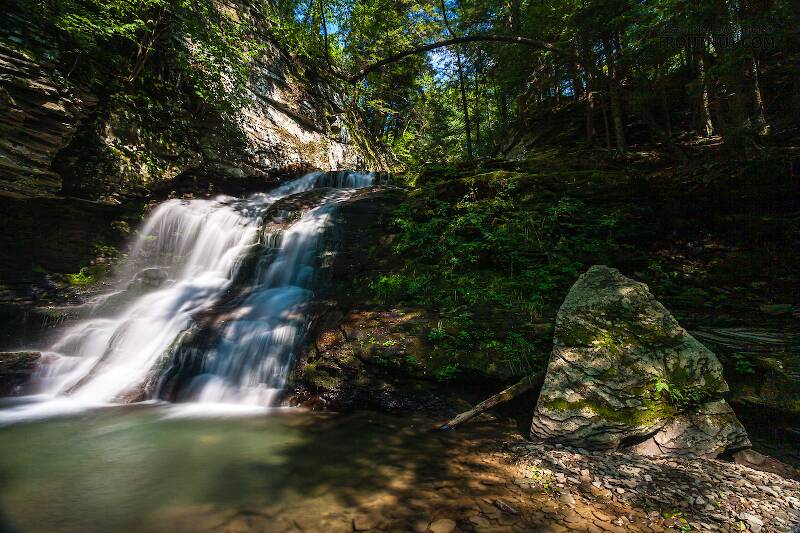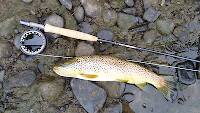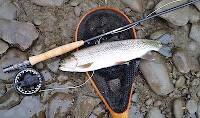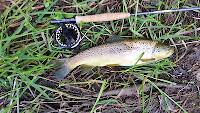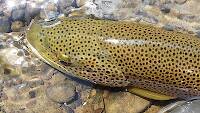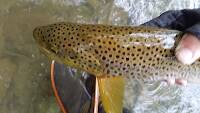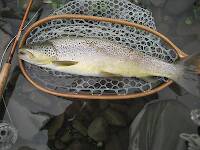
Hex Mayflies
Hexagenia limbata
The famous nocturnal Hex hatch of the Midwest (and a few other lucky locations) stirs to the surface mythically large brown trout that only touch streamers for the rest of the year.
Featured on the forum

Some characteristics from the microscope images for the tentative species id: The postero-lateral projections are found only on segment 9, not segment 8. Based on the key in Jacobus et al. (2014), it appears to key to Neoleptophlebia adoptiva or Neoleptophlebia heteronea, same as this specimen with pretty different abdominal markings. However, distinguishing between those calls for comparing the lengths of the second and third segment of the labial palp, and this one (like the other one) only seems to have two segments. So I'm stuck on them both. It's likely that the fact that they're immature nymphs stymies identification in some important way.

Troutnut is a project started in 2003 by salmonid ecologist Jason "Troutnut" Neuswanger to help anglers and
fly tyers unabashedly embrace the entomological side of the sport. Learn more about Troutnut or
support the project for an enhanced experience here.
Crepuscular on Feb 4, 2014February 4th, 2014, 4:33 am EST
Well spurred on by Spence's post in a recent thread I figured I would start it here.
Well Spence like Hewitt predicted, those dedicated anglers seem to have gotten them (the drakes) started but the Ephemera eventually died out. And as he points out in his letter to Charlie "if the conditions were really suitable for mayflies they would already be there" So I expect that considering the amount of effort required to conduct such a thing, with diminishing returns, may be a limiting factor in doing it today. Maybe once I'm retired, I'll give it a go again. I'm wondering if they still do it in England?
In terms of migration there is one form we really haven't discussed much. Human intervention. I have mentioned elsewhere that I'm re-reading Charlie Fox's classic, "This Wonderful World of Trout"...In the chapter "The Other Side of Angling" there is a discussion of transplanting mayfly eggs from one watershed to another. They did it from 1947-49.
For three years a group transplanted Green Drake, and a few Brown Drake, eggs into Yellow Breeches, Big Spring, the LeTort, and Cedar Run.They actually had correspondence about what they were doing with Edward Hewitt,Charles Wetzel, and Dr Paul Needham.
There is a discussion of this practise taking place in England with Hewitt writing about the keeper of the Test, Lunn's preferred method for transfer. They also mention an attempt to transplant mayfly eggs from England into the Neversink...(What would folks think of this today?)
Well Spence like Hewitt predicted, those dedicated anglers seem to have gotten them (the drakes) started but the Ephemera eventually died out. And as he points out in his letter to Charlie "if the conditions were really suitable for mayflies they would already be there" So I expect that considering the amount of effort required to conduct such a thing, with diminishing returns, may be a limiting factor in doing it today. Maybe once I'm retired, I'll give it a go again. I'm wondering if they still do it in England?
Feathers5
Posts: 287
Posts: 287
Feathers5 on Feb 4, 2014February 4th, 2014, 7:29 am EST
That makes sense to me.
TNEAL on Feb 4, 2014February 4th, 2014, 7:51 am EST
doesn't the same thing apply to manufacturing trout streams such as Michigan's AuSable? It's a Grayling stream that was converted by man.....
Oldredbarn on Feb 4, 2014February 4th, 2014, 2:37 pm EST
doesn't the same thing apply to manufacturing trout streams such as Michigan's AuSable? It's a Grayling stream that was converted by man.....
Thank you Rube Babbitt! :)
Spence
"Even when my best efforts fail it's a satisfying challenge, and that, after all, is the essence of fly fishing." -Chauncy Lively
"Envy not the man who lives beside the river, but the man the river flows through." Joseph T Heywood
"Envy not the man who lives beside the river, but the man the river flows through." Joseph T Heywood
TNEAL on Feb 4, 2014February 4th, 2014, 5:43 pm EST
I look good for my age
Feathers5
Posts: 287
Posts: 287
Feathers5 on Feb 5, 2014February 5th, 2014, 3:31 am EST
doesn't the same thing apply to manufacturing trout streams such as Michigan's AuSable? it's a Grayling stream that was converted by man.....
I'd say, no! Fish are able to tolerate conditions much better than bugs. I see it year after year in put-and-take creeks around me that have holdovers with virtually no bug life in the creeks.
Entoman on Feb 5, 2014February 5th, 2014, 6:08 pm EST
Eric -
Not to my knowledge, but they do husband their critters. What's cool is how they mow the ranunculus and place vertical grates for baetids to lay eggs on. Besides increasing viability the design also holds off their chief predators (caddis larvae).
I'm wondering if they still do it in England?
Not to my knowledge, but they do husband their critters. What's cool is how they mow the ranunculus and place vertical grates for baetids to lay eggs on. Besides increasing viability the design also holds off their chief predators (caddis larvae).
"It's not that I find fishing so important, it's just that I find all other endeavors of Man equally unimportant... And not nearly as much fun!" Robert Traver, Anatomy of a Fisherman
Creno on Feb 5, 2014February 5th, 2014, 8:14 pm EST
caddis can really catch baetis? I guess if the baetis drifts into a net the caddis would eat it but I would not think they are the major predator in baetis habitats.
Entoman on Feb 5, 2014February 5th, 2014, 8:50 pm EST
caddis can really catch baetis?
From what the Brits say, Dave. Apparently the free roaming species crawl up the weed stalks and other vertical objects that baetids like to use and graze away. They are quite voracious consumers of egg packets and young larvae. The grates are literally covered with eggs and the caddis are quite thick trying to get through the barrier to them. This practice supposedly increases baetid populations while reducing/limiting caddis populations.
"It's not that I find fishing so important, it's just that I find all other endeavors of Man equally unimportant... And not nearly as much fun!" Robert Traver, Anatomy of a Fisherman
Oldredbarn on Feb 6, 2014February 6th, 2014, 4:50 am EST
This practice supposedly increases baetid populations while reducing/limiting caddis populations.
What's this?! Speciesism...Don't get me wrong, I loves me them baetids, but what's wrong with a caddis?
It somehow seems to me that instead of husbanding fish and raising aquatic insects that a really healthy stream would take care of itself. Keep the estates off the banks and stop using the stream as a waste disposal system...(In anticipation of my friend Mr Neal chimming in here about the good old, pre-treatment system in Grayling, days...:)...Maybe a little crap in the river won't hurt).
It is very difficult, isn't it, to draw a line when it comes to human intervention...We joke about the old time chasing the hatchery truck, but what about our "blue-ribbon" streams isn't man-ipulated? We dump the steelhead smolts in and then chase them around when their adults...We improve structure in our streams in an attempt to increase its carrying capacity...Etc.
How "wild" is wild these days? Are we pretending? Is it really only about how many and how big? We have engineered a zoo. I love to fish the Mason Tract that the South Branch of the Au Sable runs through because it "seems" wild...Somewhere in the back of my brain I still know how to get back to the car, the cooler of sandwiches and beer, and a clean warm bed at the Lodge. It's play.
Charlie Fox and his gang even tried to add fish to the famous Letort that appeared to be good "risers" in hopes of improving the dry-fly action on the stream...Those sulky old German imports could be problematic to the dry-fly purists at times. :)
Eric...Keep telling them that the river don't fish anymore, that the glory days are done, add in a grumble or two from Matt, and in April it will be just you and I, and maybe "the good doctor", grinning ear-to-ear while we hassle your "pets". :)
You going to post that latest pic or do you not want to blow our cover?! :)
Spence
"Even when my best efforts fail it's a satisfying challenge, and that, after all, is the essence of fly fishing." -Chauncy Lively
"Envy not the man who lives beside the river, but the man the river flows through." Joseph T Heywood
"Envy not the man who lives beside the river, but the man the river flows through." Joseph T Heywood
Entoman on Feb 6, 2014February 6th, 2014, 10:01 am EST
What's this?! Speciesism...Don't get me wrong, I loves me them baetids, but what's wrong with a caddis?
Ha! It's all about the dry fly for the British, Spence - preferably fished upstream with a dead drift. I guess those particular species of caddis don't provide it. Speciest thugs....:)lol
"It's not that I find fishing so important, it's just that I find all other endeavors of Man equally unimportant... And not nearly as much fun!" Robert Traver, Anatomy of a Fisherman
PaulRoberts on Feb 6, 2014February 6th, 2014, 2:36 pm EST
It somehow seems to me that instead of husbanding fish and raising aquatic insects that a really healthy stream would take care of itself.
Most people, including anglers, want more than nature can produce left to its "randomness", especially in an enormously human impacted world. We're also suckers for images -and small trout don't sell magazines and gear and stuff like big fish do.
How "wild" is wild these days? Are we pretending? Is it really only about how many and how big? We have engineered a zoo. I love to fish the Mason Tract that the South Branch of the Au Sable runs through because it "seems" wild...Somewhere in the back of my brain I still know how to get back to the car, the cooler of sandwiches and beer, and a clean warm bed at the Lodge. It's play.
True enough. At the same time, no one, not even the most radical Paleo folks, would actually want to go back 12,000 years -and stay there.
TNEAL on Feb 7, 2014February 7th, 2014, 2:47 am EST
Some Years ago, he trout population on Michigan's AuSable took a big hit seemingly over the course of one season.The year it really showed up was 1989. Populations have never really recovered, at least not to the levels they were before that. Lots of theories were advance; nothing conclusive. john Norcross, a retired fisheries biologist commented: "We may be seeing the tail-end of a failed experiment." That's always stuck in my mind.
Crepuscular on Feb 7, 2014February 7th, 2014, 4:03 am EST
Some Years ago, he trout population on Michigan's AuSable took a big hit seemingly over the course of one season.The year it really showed up was 1989. Populations have never really recovered, at least not to the levels they were before that. Lots of theories were advance; nothing conclusive. john Norcross, a retired fisheries biologist commented: "We may be seeing the tail-end of a failed experiment." That's always stuck in my mind.
Yeah Tim that would stick with me too. Afterall all of these brown trout fisheries are, in reality, experiments. And I suppose things could go wrong quick. As a side note, from what I heard recently from a Michigan angling author, the AuSable could use a shot of nutrients, that the place hasn't been the same since they worked on the septic systems in the watershed.
Jmd123 on Feb 7, 2014February 7th, 2014, 9:47 am EST
"How "wild" is wild these days?"
Good question. I would certainly say, and perhaps most if not all of you would agree, that any stream or other water body that receives significant hatchery input is not "wild" but rather "maintained". The two trout streams that I fish are a study in contrasts.
The Rifle River receives heavy stocking input, both of brown trout and of steelhead. This river receives heavy fishing pressure in the summer, especially in the Rifle River Recreation Area where everyone goes camping and wants a trout dinner every night (or even breakfast). But they seem to do a damned good job of faking it, I can't remember catching a brown, even a smaller one, that looked like it came out of a hatchery raceway. All the fish I've caught there are beautifully colored with nicely developed fins, and they fight hard for their size no matter what size they are (many of them actually leap like rainbows!).
The Pine River, on the other hand, has apparently not been stocked for a very long time, at least the MDNR stocking website has no listing for the Pine for the last 30 years except for one small private planting of brookies on a different branch than I fish some years ago. So these fish are wild, beautiful brookies and rainbows. They don't get very big, after all this is a small stream averaging maybe 7-15 ft. wide and not terribly deep though there are some holes that will go up to your chest. The biggest I've caught are 11" brookies (though others have caught them 13"+) and two summers ago I nailed a 14" rainbow there. These are NOT heavily fished waters, at least I haven't run into many others out there, and access is limited. People who catch the biggest ones have told me that they hike through several miles of swamp to get to their favorite spots...
And then there's [REDACTED] Pond, which seems like it was purposely built to be a brookie factory. It's a small impoundment of maybe 10 or more acres with a spring-fed feeder creek running into it. Hiking up the creek, one can find five or six artificial spawning beds - gravel that doesn't look like it was originally found there (everything else is sand or silt) placed between two parallel logs forming chutes that keep the water velocity up and the gravel clean. Above this is an artificially deep pool that was dug as a silt trap to keep the silt off the gravel beds. A family who was camping there last summer told me that the Forest Service had told them they put the brookies in the pond (there's also perch that were introduced accidentally and which serve to come home as food...). So now these brookies have a place to live, grow, AND spawn, so they are becoming "wild" I suppose.
All three of these fisheries are artificial - the Michigan grayling is supposed to be the native around here too (the Pine is a tributary system to the low Au Sable). I do enjoy them all, but of the three, the Pine is certainly the "wildest".
Just my 2 cents here...
Jonathon
Good question. I would certainly say, and perhaps most if not all of you would agree, that any stream or other water body that receives significant hatchery input is not "wild" but rather "maintained". The two trout streams that I fish are a study in contrasts.
The Rifle River receives heavy stocking input, both of brown trout and of steelhead. This river receives heavy fishing pressure in the summer, especially in the Rifle River Recreation Area where everyone goes camping and wants a trout dinner every night (or even breakfast). But they seem to do a damned good job of faking it, I can't remember catching a brown, even a smaller one, that looked like it came out of a hatchery raceway. All the fish I've caught there are beautifully colored with nicely developed fins, and they fight hard for their size no matter what size they are (many of them actually leap like rainbows!).
The Pine River, on the other hand, has apparently not been stocked for a very long time, at least the MDNR stocking website has no listing for the Pine for the last 30 years except for one small private planting of brookies on a different branch than I fish some years ago. So these fish are wild, beautiful brookies and rainbows. They don't get very big, after all this is a small stream averaging maybe 7-15 ft. wide and not terribly deep though there are some holes that will go up to your chest. The biggest I've caught are 11" brookies (though others have caught them 13"+) and two summers ago I nailed a 14" rainbow there. These are NOT heavily fished waters, at least I haven't run into many others out there, and access is limited. People who catch the biggest ones have told me that they hike through several miles of swamp to get to their favorite spots...
And then there's [REDACTED] Pond, which seems like it was purposely built to be a brookie factory. It's a small impoundment of maybe 10 or more acres with a spring-fed feeder creek running into it. Hiking up the creek, one can find five or six artificial spawning beds - gravel that doesn't look like it was originally found there (everything else is sand or silt) placed between two parallel logs forming chutes that keep the water velocity up and the gravel clean. Above this is an artificially deep pool that was dug as a silt trap to keep the silt off the gravel beds. A family who was camping there last summer told me that the Forest Service had told them they put the brookies in the pond (there's also perch that were introduced accidentally and which serve to come home as food...). So now these brookies have a place to live, grow, AND spawn, so they are becoming "wild" I suppose.
All three of these fisheries are artificial - the Michigan grayling is supposed to be the native around here too (the Pine is a tributary system to the low Au Sable). I do enjoy them all, but of the three, the Pine is certainly the "wildest".
Just my 2 cents here...
Jonathon
No matter how big the one you just caught is, there's always a bigger one out there somewhere...
Quick Reply
Related Discussions
Topic
Replies
Last Reply
1
Sep 14, 2010
by SlateDrake9
by SlateDrake9
Re: Which aquatic insects are most vulnerable to pollution???
In the Identify This! Board by Byhaugh
In the Identify This! Board by Byhaugh
4
Aug 14, 2014
by Lastchance
by Lastchance
2
May 27, 2017
by Partsman
by Partsman
1
Mar 10, 2007
by Troutnut
by Troutnut

